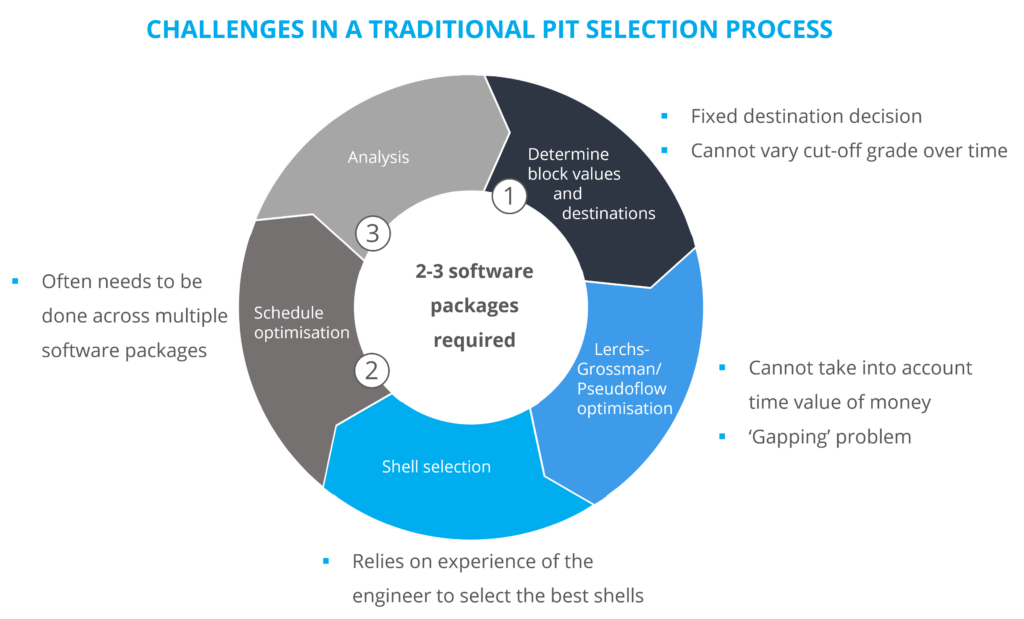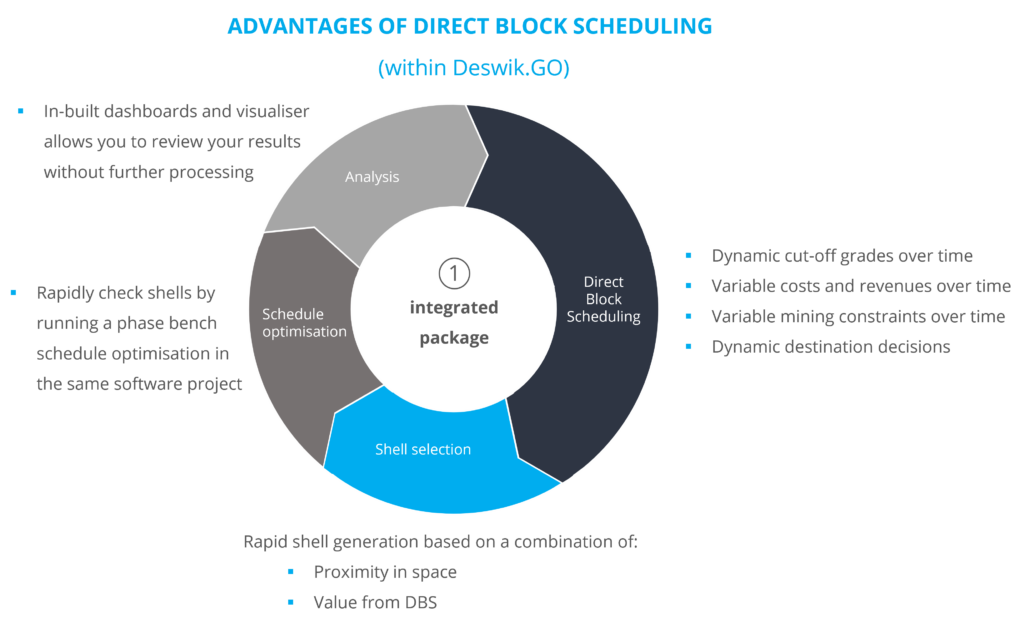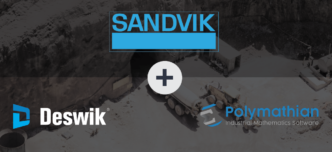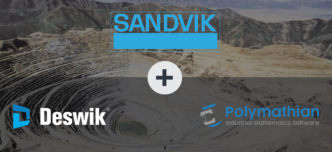A new approach to pit optimization
In every mining venture, determining the ultimate pit limit remains the core challenge for mine planners to ensure a successful project. Despite advancements in mathematics and software technology, the complexity of pit optimization has yet to be solved in a single equation.
This is not to say that there has not been progress to solving the problem. Since the proposal of the Lerchs-Grossman algorithm in 1965, steady improvements have been made in the pit optimization space. Alternative methods have emerged over the years with each new method better capturing the complexity of pit optimization by considering new variables.
Among these new methods is Direct Block Scheduling (DBS). This latest approach considers the implications of time variables during the planning process to ensure a truly optimized pit shape. Given this added benefit, Direct Block Scheduling is proving itself to be the industry’s next step change, bringing mines another step closer to optimized operations.

What is the pit optimization problem?
Pit optimization sets out to answer the most fundamental questions about pit shape, mine scheduling and economics.
For a greenfield site, these questions may include:
- What is the ultimate pit limit?
- What capacity should the plant be?
- Is it worth acquiring a neighboring lease?
- What should internal phases look like?
Alternatively, for a brownfield operation, the questions may be:
- Are the existing phases still valid?
- Should one mining area develop before another?
- Will capital expenditure to increase mining rates add value to the mine?
While these questions are not unsolvable, they are complex and involve many stages of problem definition and analysis.
The industry’s go-to method
The current approach to solving these problems involves a mixture of optimization techniques and heuristics. This approach consists of three primary steps:
- Find the ultimate pit limit
- Select internal phases
- Determine mining and processing schedules
For the ultimate pit limit problem, the Lerchs-Grossman (LG) and Pseudoflow algorithms are commonly used and are the accepted industry standards. These algorithms are both variants of the maximum closure problem and generate a series of shells by varying the input revenue for a fixed set of costs. While both algorithms are typically fast and produce reliable and repeatable answers, they are unable to account for capacity constraints or the time value of money.
After selecting the ultimate pit limit, revenue factor shells from LG or Pseudoflow algorithms are generally used to determine candidate shapes for internal phases. Phase selection is a highly iterative process considering items like operational geometries, total volume, and ore delivery to processing.
For the mine production scheduling problem, a mixed-integer linear programming (MILP) approach is normally taken. This allows the source and destination problem to be simultaneously optimized while giving excellent guidance on when new areas should be opened, what material should feed the plant, and long-term stockpiling strategies. However, traditional MILP problems often become too large to solve in a reasonable amount of time if there are too many mining decisions to be made, or too many constraints applied.

A new approach
Direct block scheduling (DBS) is a new technique for pit optimization and strategic scheduling. DBS utilizes MILP to find the optimal pit limit by determining when each block is extracted and whether that block is ore or waste. DBS techniques are possible due to recent mathematical advances such as the Bienstock-Zuckerberg (BZ) algorithm. This new algorithm takes into account specific characteristics of the mine scheduling problem to quickly solve parts of the MILP process.
This approach optimizes the pit while simultaneously considering the discount rate and time variable capacity constraints, capital decisions, costs and commodity prices. The block extraction sequence is delivered on a block-by-block basis to provide clear guidance for phase selection. This allows mines to gain deep insights into the economics of their deposit while accounting for the most critical aspects of mining and processing.
The most important aspect of DBS for pit optimization is the consideration of time variables. These include spatial constraints that can model major infrastructure moves, future permit boundary changes, and dewatering limitations. These combined with other time variables applied to costs, revenues and capacity constraints allow for dynamic cut-off grades (COG) that change in each mining period. Dynamic COGs are applied to simple ore-waste definition as well as correctly routing ore to multiple processing facilities that may be competing for ore.

Another benefit to DBS is the ability to consider multiple block models during optimization. These different areas of the mine can share limited mining and processing resources to provide realistic pit solutions. Multiple block models can also be used to approximate competitive processing pressures from external ore sources like underground mines or concentrate shipments. This ensures that material from the pit is extracted in the right mining period and routed to the best possible destination.
Beyond the ultimate pit shape and ore routing, internal phase selection has an immense impact on the value of any open pit. Legacy revenue factor pit shells from LG/Pseudoflow give some indications for phase selection. However, these pit shells cannot respect many operational and financial constraints. As a result, there are many cases where revenue factor shells do not provide good outcomes for phase selection. The block-by-block solution generated through DBS pit optimization shows exactly where the pit should be progressing in each period of time. This gives strong guidance on where to define internal phases which leads to a more valuable pit design.
Direct block scheduling in practice
The application of DBS in pit optimization and scheduling provides several business benefits.
The most significant impact is increased value for projects. In the legacy optimization workflow using LG/Pseudoflow, good solutions could be found through many iterations but rarely were these solutions truly optimal. Generalizations and assumptions that feed into the legacy workflow prevent mines from finding their full potential. These assumptions leave untapped value within the project at the most critical stage of evaluation and mine planning. DBS pit optimization can directly account for many of the most complex aspects of pit optimization. By directly accounting for these parameters, the optimizer delivers a globally optimal solution. This allows businesses to increase their return on investment and focus planning efforts on areas of greatest importance.
Aside from simply increasing project value, utilization of DBS can also reduce the risk associated with a mining project. Reducing the number of iterations per scenario gives businesses the opportunity to test far more scenarios than was possible before. These extra scenarios can lead to insights into project sensitivities or be used to test mitigation strategies. Additional risk reduction comes by limiting the number of assumptions needed during pit optimization. DBS is capable of directly accounting for variable costs, commodity prices, and operational bottlenecks. By clearly defining these time variants throughout the life of mine, DBS pit optimization delivers a finely tuned solution for a wide range of inputs.

What does this mean for future operations?
While DBS is a relatively new approach in the world of pit optimization, it is available in a few commercial software packages. Among these is Deswik Global Optimization (Deswik.GO) which uses DBS to solve the pit optimization problem and other MILP methods for more detailed strategic mine planning. The application of DBS for pit optimization continues to become more common as mining companies move to using these methods to create more value from their operations.
Both LG and Pseudoflow algorithms were major steps forward in the field of pit optimization for their time, but the path to optimization is an ongoing process. DBS unlocks the potential of time variables to deliver optimal pit shapes that conform to realistic scenarios and generate the best possible value for each mine.
This article was featured in the June issue of Global Mining Review.




